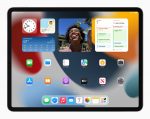“Your next computer, isn’t a computer,” Apple boldly claimed in an ad for the iPad Pro a couple years ago. Though you’ll notice that slogan has conspicuously disappeared from their marketing. And for good reason, because it’s all too true.
The 2021 iPad Pro is certainly an absolute banger of a tablet. It features the same 8-core M1 processor featured across the entire Macintosh stack, complete with up to 16GB of RAM and a beefy 2TB SSD. Something rather unusual for a company that’s notoriously stingy with memory and storage. It also features what pundits are calling one of the best displays ever on a mobile device, thanks to its micro-LED back lighting. Meanwhile a single USB-C Thunderbolt port returns, giving it a near endless amount of peripherals. At $799 USD for the base 11” model, you’re getting a lot of machine for a fairly reasonable price. Except, well, despite being the Pro branding, this thing is anything but pro. What’s holding the iPad Pro back isn’t the hardware, but rather the software. Specifically iPadOS.
Even at its launch, the iPad was criticized for being little more than a giant iPod Touch. And for most of its history, that’s exactly what it was. The iPad filled a niche between smartphones and laptops at a time when the former were too small for media consumption and light productivity, and the latter too cumbersome and expensive for casual use. While iOS got adapted to work with this form factor, it was never ideal. Multitasking was rubbish, it had too little RAM and storage for any serious work, external and networked storage devices were verboten, and you couldn’t install any software that wasn’t on the App Store. Well, unless you went through the effort of jailbreaking, which many power users like myself did just to make the device more functional. Of course getting those features involved voiding warranties and having to forego critical security updates. Basically the iPad kind of sucked at what it was trying to be; a laptop replacement.
However, with the introduction of the iPad Pro, it seemed like Apple was eager to develop tablets that would finally appeal to power users, businesses, and creative professionals. A market which Microsoft was focusing on with their Surface Pro. Unfortunately, bog standard iOS just wasn’t going to cut the mustard anymore. So they began modifying it to better suit the tablet form factor.
The results are, well, something that sort of hovers in between full fat MacOS and iOS. Complete with all the shortcomings of both, but few of the advantages.
Don’t get me wrong, iPadOS has drastically improved the functionality of iOS. Easier file browsing and multitasking, support for external Thunderbolt peripherals, and a far better UI that actually takes advantage of the bigger screen real estate. However, it still has issues with networking, doesn’t support extended displays, doesn’t allow apps to use more than 5GB of RAM, has mouse support that’s really just touch emulation, and perhaps more importantly, still relies on the same walled garden ecosystem. Meaning that using any specialized, or cheeky, software still requires either Apple approval, or jailbreaking, since iPadOS doesn’t allow the sideloading of apps like Android does. And as we’ve seen from their recent legal battle with Epic, they also like to play favourites when it comes to what does and doesn’t get approved for the store. Often for rather dubious reasons.
Now, these limitations aren’t such a big deal if you’re using an iPad as a replacement for casual computing. However, that’s the whole problem here. The iPad has always been seen as this media consumption device. Something which Apple is trying hard to get away from if they’re marketing is to be believed. Yet the iPad Pro still feels like it’s trapped in the media consumption world, from the core design of the OS to how its entire ecosystem functions. There’s nothing that it can do that a similarly priced and equipped 13” MacBook Pro can’t do far better. Well, aside from being used as a drawing tablet. So unless you’re an artist, why would you want one? It’s a product in search of a purpose.
Now, its primary competitor, the Surface Pro, has the opposite problem. Windows 10’s tablet mode is absolutely atrocious to put it politely. The ecosystem for touch supported apps via the Windows Store is also pathetic. Despite my ragging on iPadOS, it is far superior when you’re using your device primarily as a tablet, rather than a laptop replacement. Microsoft feels like they’re a decade behind Apple on this front, and I don’t see things changing with Windows 11.
That said, Windows is still Windows no matter what device you run it on, with all the advantages and caveats there in. The Surface Pro comes with the same full fat version of Windows 10 that every other desktop and laptop PC runs. Which means it can run just about any application designed for Windows, provided of course the hardware is capable of running it. Whether it be industry specific tools, console emulators, or full desktop software suites.
Now the Surface Pro does indeed have a lot of faults. It’s a lot more expensive than the iPad Pro for one. There’s a butt puckering $800 CAD price difference between the 16GB/1TB SSD models. Neither of which come with a pen or keyboard. But even with both the Apple Pencil and the ludicrously overpriced Magic Keyboard included, the iPad Pro still comes out $100 cheaper than the similarly equipped Surface with no accessories.
The Ice Lake-U Core i7 1065G7 is also about 20% slower than the M1 over all, with about 40% less battery life. While the overall design of the tablet is better (love me that kickstand and storage expansion), the Surface is really lacking on features such as Thunderbolt. Which is inexcusable given this is an Intel device. While they do have a single USB-C port now, it still requires a proprietary charger. At least you can use any PC peripherals with it.
It’s clear that Microsoft’s tablet isn’t for everyone. This is certainly an area where Apple could stage a major coup and put Surface out to pasture, if they’d just treat it like a Macintosh tablet rather than a tricked out iPhone.
With the introduction of the M1 processor across its entire product stack, the lines have really began to blur between Apple’s laptops and mobile devices. MacOS Big Sur can already run iOS apps natively. So why is iPadOS, at least on the iPad Pro, still being locked down? The obvious answer is to keep you locked into their store monopoly. But I wonder if that’s hurting more than helping for a device of this tier. Obviously I think it’s the former.
I would argue that the iPad Pro should be sold as a 2-in-one to replace the MacBook Air as their entry level laptop. The Air is already so closely spec’d and priced to the 13” MacBook Pro that it really doesn’t need to exist. Besides, Apple can more than afford to take the hit by adding a keyboard in-box. with the iPad. But it needs to be able to run all the apps that MacOS can if they really want to position it as such. Not to mention all the other advantages of the desktop class OS like better networking and easier file browsing. If they did that, I’d buy an iPad Pro tomorrow, no question. But in the meantime, the Surface is still the best option for power users who want a true tablet that can do it all. Even if it is grossly overpriced.
Image via Apple




